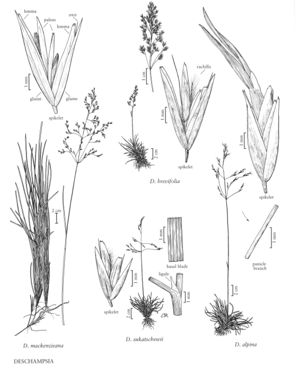Difference between revisions of "Deschampsia mackenzieana"
FNA>Volume Importer |
FNA>Volume Importer |
||
| Line 16: | Line 16: | ||
-->{{Treatment/Body | -->{{Treatment/Body | ||
| − | |discussion=<p | + | |discussion=<p>Deschampsia mackenzieana grows on the sandy shores and dunes around Great Slave Lake, Northwest Territories, and Lake Athabasca, Saskatchewan. The decumbent culms of some plants may be a response to shifting substrate.</p> |
|tables= | |tables= | ||
|references= | |references= | ||
| Line 32: | Line 32: | ||
|basionyms= | |basionyms= | ||
|family=Poaceae | |family=Poaceae | ||
| + | |illustrator=Cindy Roché | ||
|reference=None | |reference=None | ||
|publication title= | |publication title= | ||
|publication year= | |publication year= | ||
|special status= | |special status= | ||
| − | |source xml=https:// | + | |source xml=https://bibilujan@bitbucket.org/aafc-mbb/fna-data-curation.git/src/314eb390f968962f596ae85f506b4b3db8683b1b/coarse_grained_fna_xml/V24/V24_896.xml |
|subfamily=Poaceae subfam. Pooideae | |subfamily=Poaceae subfam. Pooideae | ||
|tribe=Poaceae tribe Poeae | |tribe=Poaceae tribe Poeae | ||
Revision as of 16:10, 30 October 2019
Plants loosely cespitose. Culms 30-80 cm, smooth, glabrous, sometimes decumbent at the base and rooting at the lower nodes. Basal leaves not forming a tuft; sheaths smooth; ligules 4-7.5 mm, acute; blades 1-3 mm wide, convolute to involute, abaxial surfaces smooth, adaxial surfaces scabrous. Panicles 10-20 cm long, 8-14 cm wide; branches ascending to laxly diverging or reflexed, somewhat scabrous, longest branches at the lower nodes usually undivided for 1/3-1/2 their length. Spikelets 6-7.5 mm, bisexual. Glumes acuminate, equaling or slightly longer than the distal floret; callus hairs 1.5-2 mm; lemmas 4.5-5.5 mm, awns attached on the lower 1/4 - 2/3, inconspicuous, weakly geniculate, from shorter than to exceeding the lemma by approximately 2 mm; anthers 1.5-2.7 mm. 2n = 52.
Discussion
Deschampsia mackenzieana grows on the sandy shores and dunes around Great Slave Lake, Northwest Territories, and Lake Athabasca, Saskatchewan. The decumbent culms of some plants may be a response to shifting substrate.
Selected References
None.
